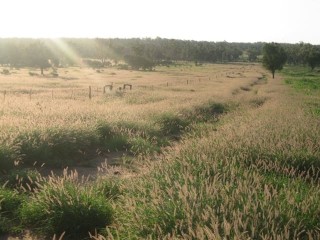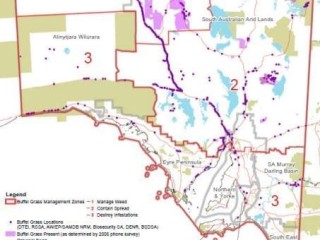 It is one of the four ‘B’s that along with bladeploughs, barbed wire and Brahmans has helped to unlock greater productivity increases in northern Australia, but Buffel grass is proving far less popular in the south.
It is one of the four ‘B’s that along with bladeploughs, barbed wire and Brahmans has helped to unlock greater productivity increases in northern Australia, but Buffel grass is proving far less popular in the south.
Biosecurity South Australia has described the introduced pasture species as a serious invader that has the potential to spread rapidly, form dense monocultures, threaten biodiversity and destroy ecosystems across the region.
The organisation says that with minimum stands currently present, South Australia is in a unique position to prevent the spread of Buffel Grass.
It has a developed a draft strategy designed to achieve that aim and is currently seeking public comment.
Biosecurity SA’s Manager of NRM Biosecurity, Dr John Virtue, said Buffel grass currently posed the greatest threat in the State’s arid and semi-arid rangelands.
“Buffel grass (or Cenchrus ciliaris) is a perennial tussock grass native to Africa, India and Asia,” Dr Virtue said.
“Since the late 1950s, it’s been a major pasture grass sown in northern Australia but has spread into South Australia in recent decades.
“The benefits of Buffel grass for livestock production, however, must be compared with its serious conservation and social impacts.
“It can form dense monocultures, change natural fire regimes and threaten the survival of rare native plants and animals.
“With the need to manage fire risk and protect assets, and the loss of diversity in native pastures, Buffel grass can actually pose significant production costs.
“Buffel grass is not approved for planting in the pastoral regions, which has put South Australia in a unique position to take strategic actions now to protect our precious rangelands.”
 Dr Virtue said climatic modelling predicted Buffel grass, if left unchecked, could establish over most of the State in the longer term.
Dr Virtue said climatic modelling predicted Buffel grass, if left unchecked, could establish over most of the State in the longer term.
Once established, there was no single control method available for the successful management of buffel grass over extensive areas. The potential success of management was higher if buffel grass was controlled during the early stages of invasion.
Biosecurity SA’s Draft Buffel Grass Strategic Plan for South Australia is open for comment until 31 July 2012.
The draft strategy aims to exclude the entry of buffel grass into South Australia and to take a zone by zone approach to manage and contain existing buffel grass stands, which exist in the northern part of the state.
If adopted the strategy could see landholders discouraged from planting buffel grass, a statewide declaration to prevent entry, movement or sale of buffel seed within South Australia, and individual NRM boards given the authority to order landowners to control or destroy buffel plants on their properties.
The strategy also notes that the rapid growth of the mining industry presents particular challenges through the spread of seed during earthworks and road building processes.
The strategy would include surveys to identify buffel grass presence, and the development of a public education campaign
“The plan is part of a strategic approach to South Australia’s weed management. The overall aim is to lessen the damage caused by weeds in relation to the environment, property, infrastructure and public health,” Dr Virtue said.
“This draft Buffel grass strategic plan will aid the development of state policy and regional weed management plans to direct on-ground programs to prevent the spread of Buffel grass in South Australia.”
Copies of the plan and online submissions can be lodged here or forwarded to: Tim Reynolds, Biosecurity SA, GPO Box 1671 Adelaide SA 5001
A widely-acknowledged rundown in sown pasture productivity across northern Australia's grazing lands has prompted Meat and Livestock Australia to fund a five year investigative project led by Toowoomba-based Queensland Department of Agriculture, Fisheries and Forestry pasture agronomist Brian Johnson. See Beef Central's earlier report by clicking here. To read a case study on what Central Queensland producers Sam and Laurice Morris are tackling the problem, click here
